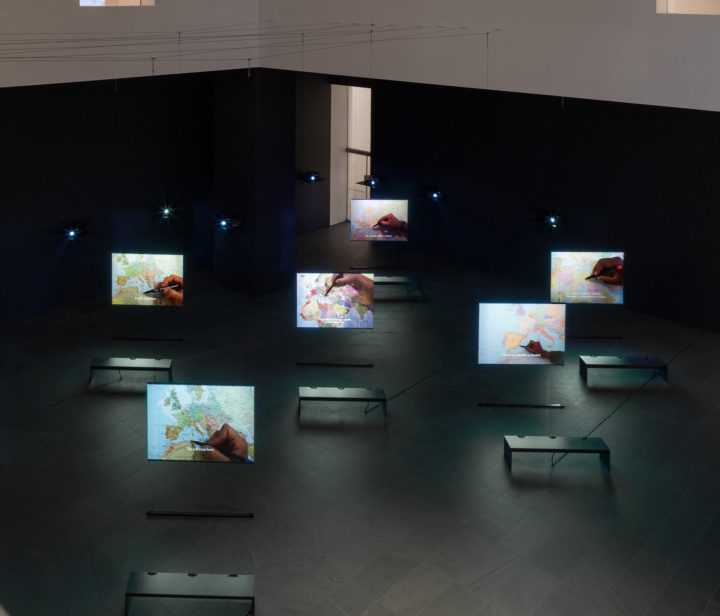MoMA Presents Bouchra Khalili’s “Mapping Journey Project”
by Gabriela Jurosz-Landa
Eight screens hang in the open space of the Marron Atrium. Each of the videos depicts a map of a part of Europe and Africa. A hand with a pen traces a refugee’s journey. Their voices recount the journey… seeing no trees…the heat … the time spent in the desert, or in cars…
Many refugees speak in Arabic, others in the language of their home country while the text is transcribed into English as subtitles.
Language can be authentic to one, but extraneous to another. As a non-Arabic viewer I felt detached from the experience, while hoping some aspect of the installation will wake me up from the somnolence. The exhibit may be well geared to refugees who went through the experience themselves, who need no explanation and who may wish to re-evaluate their own journey by watching the videos, distanced from their catastrophic experience.
Once again, peoples’ lives, other than those in the United States, appear on a distance planet. What is one to make of, “I left from Syria or Libya?” Two of the interviewees give some contextual details of their tribal differences. A Palestinian man describes the road he took to visit his girlfriend. “It’s a dangerous zone,” he says.
What can such a statement mean to an audience that experiences the refugee crisis as sound bites on the nightly news, if at all it is featured there? It may be difficult for many who did not experience forced exile to fully appreciate or understand or sense the catastrophe.
Forced exile occurs mostly in war. No mother takes her children out to sea unless the condition on land is unbearable. Thus, war becomes personal. Being a refugee is a numbing experience. Refugees lose their ancestral home and all they had built in life. They get disconnected from their family members. Children see their parents being tortured, their sisters raped. If they can make it out, the new challenges are no better. Depending on the good will of strangers and cash-strapped governments, relearning new skills and languages, adapting to foreign cultures and living within environment of foreign religions are some of the challenges refugees face. Their future is bleak, with little or no hope of returning home, and if they do, it is to a destroyed country. Being uprooted, they may lose their confidence in themselves and hope in life as well. This is the story that could have been told at MOMA.
But MOMA’s presentation seems an obstructed journey towards Europe, including Israel, which is not one of the refugee routes or destinations even though the videos propagate that point of view. Why?
Consider for instance, “I had to go through the checkpoints.” a narrator says, “Then, a long way on foot. They can be firing in this area, I managed to pass on to Jerusalem. It’s been month and a half I have been here … the roads have to change perpetually.”
Many times the voice over of sporadic refugee-interviews does not fully describe the situation: What were the questions the interviewer asked?
I was hoping for the viewer to come close to understanding what the refugees go through. Nothing in the installation made me feel their heartache. Instead, I heard a name-dropping of places echoing a summer trip abroad: Lampedusa, Rome, Marseille. These statements, and the exhibition all-together fail to redefine those places for an audience who regard those places as tourist sights, at least many certainly do. Many have not experienced those cities from a refugee’s point of view. The installation fails to use an opportunity to explain the broader context.
The major cities in Europe have been hubs of history for centuries and, once again, are in the process of transforming themselves, which will inevitably change millions of lives, including those of the refugees, for generations to come.
Is this all that “art” offers? Bouchra Khalili (Moroccan-French, born 1975), a migrant herself, living in Berlin, could have done better. The introductory wall-text claims the exhibition to “developing critical and ethical approaches to questions of citizenship, community, and political agency.” Wishful thinking. In reality, this installation seems a quick fix, at best a hurried attempt to get on the bandwagon of the refugee crisis before the Evening News or Social Media try whatever it takes to grab our deficient attention.
Despite MoMA’s effort to present itself as a platform for political insight, in this installation, sadly, the life of refugee becomes only an uncritical Power-Point presentation.
– – – – – – – – – – – – – – – – – – – – – – – – – – – – – – – – – – – – – – – – – – – – – – – – – – – – – – – – – – – – – –
Gabriela Jurosz-Landa is a scholar of art anthropology and anthropology. She lectures and publishes on topics of art and museology, Mayan traditions and spirituality, Czech cultural philosophy, and city-anthropology. She is a member of the Czech Association of Art Historians in Prague, and the jury of Berlin-based literary contest Federleicht. As founder and president of Forum of World Cultures, she organizes international cultural-political events. She has contributed to ANTHROPOS-Journal, the BBC, ART NEWS, DIE WELT Germany, MUENCHENER MERKUR, ATELIER Prague, Euro-Journal, PRAGER WOCHENBLATT, EL NUEVO DIARIO Nicaragua, THE REVUE Guatemala, SFERA and MLADY SVET Prague. Ms. Jurosz-Landa’s essay Emmigrantenkinder received an award from the inter-cultural magazine Český Dialog. She currently resides in New York City.










